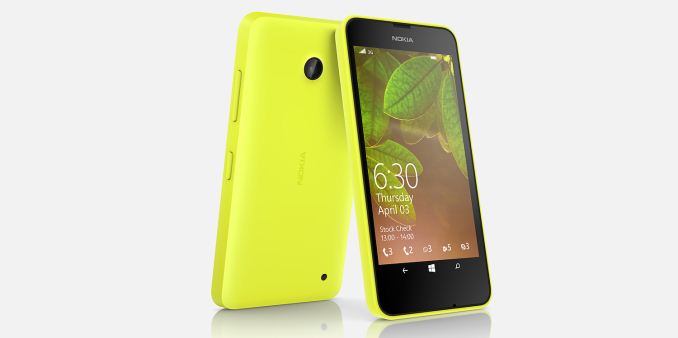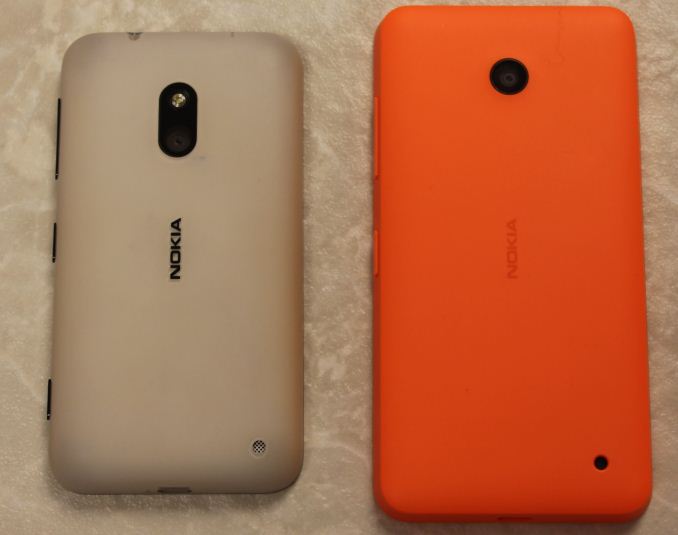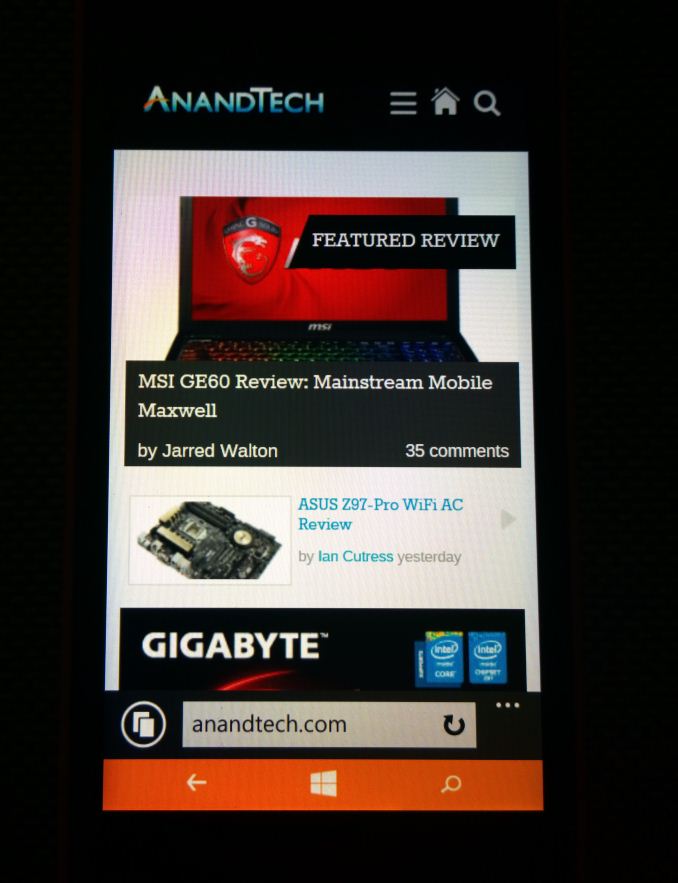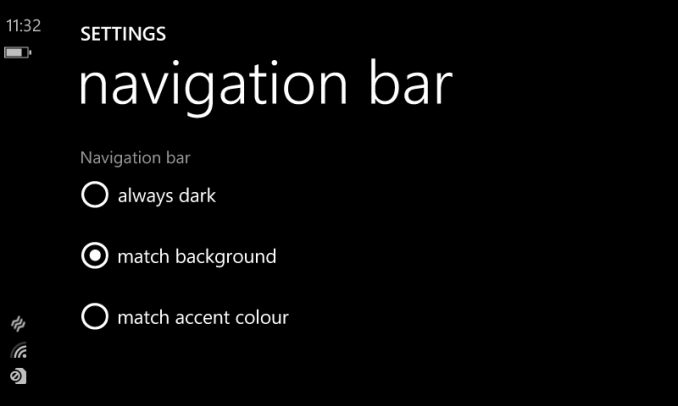Nokia Lumia 630 Review
by Brett Howse on July 22, 2014 8:00 AM EST- Posted in
- Smartphones
- Microsoft
- Nokia
- Mobile
- windows phone
Hardware
The first thing that anyone will ever do with a smartphone is hold it, so we will start with the design of the phone. If you have ever seen or held any Lumia phone, then you will instantly recognize the 630 as a Lumia. The polycarbonate back is much thinner and more flexible than the 620, but has an excellent matte texture to it which makes it easy to grip and hold. The design has progressed from the earlier Lumia models with removable backs, and now features nicely rounded corners, and an angular side which makes the device quite comfortable to hold on to.
As is often the case with Lumia phones, there are several colors to choose from and in this case you can get white, black, yellow, green, or the color I received as a review unit which is a nice bright orange. As someone who has always owned black phones, I have to say that I’ve grown to really like the orange.
The power and volume buttons can be found on the right side of the device, with the micro USB port on the bottom, and the 3.5 mm jack on top. The back has the 5 MP camera sensor, a speaker hole, and a very faint Nokia logo. There is no fake chrome, or fake leather. This is a plastic phone that is made out of quality plastic, and with the small by today’s standard display of 4.5”, the phone fits nicely in the hand and is quite comfortable to hold.
The back of the device peels off, unlike older Lumia phones which definitely popped off. Behind the removable back cover we get easy access to the SIM slot (or dual SIMs if applicable) as well as the replacable battery and a microSD slot.
 Lumia 620 (left) vs Lumia 630 (right)
Lumia 620 (left) vs Lumia 630 (right)
The move to on-screen buttons for the back, home, and search keys was something that took me no time to adjust to. You can set the device to provide haptic feedback of button presses, and in that sense they work and feel exactly like the capacitive buttons of most phones. I also accidentally triggered the buttons less than the hardware buttons of other phones I’ve used, which I attribute to not having the buttons so low on the device, so if I rest my thumb at the bottom, I don’t hit search. A nice touch to the on-screen buttons is you can customize the navigation bar color to be always dark, match the background, or match the accent color.
The one thing I do miss though is the camera button, and perhaps that’s because Windows Phone 8.1 isn’t ready to give this button up yet. There’s no easy way to access the camera from the lock screen like on competing operating systems, and with other Windows Phones that’s not an issue because of the physical button to launch the camera. The workaround on this device is that one of the quick action buttons in the action center is set to the camera function out of the box. It is not the ideal fix, and I hope they add a slide right for camera experience to the start and lock screens in a future update to address this issue.
As far as the specifications, the Lumia 630 is also the first Windows Phone to sport the Snapdragon 400 class of SoC. This brings the MSM8226 model which is a quad-core Cortex A7 CPU at 1.2 GHz, Adreno 305 Graphics, integrated modem, and improved ISP over the Snapdragon S4 of the previous generation. Also in-line with the Lumia 520 and 620 is the 512 MB of RAM which is a shame in 2014. Windows Phone as an OS gets by just fine with 512 MB of RAM, but many games in the store are limited to devices with at least 1 GB of RAM, so it would have been nice to see the 630 include the 1 GB to open the device to all apps in the store. The full specifications are listed below.
| Lumia 630 Specifications | ||||
| Nokia Lumia 520 | Nokia Lumia 620 | Nokia Lumia 625 | Nokia Lumia 630 | |
| CPU |
Qualcomm Snapdragon S4 Plus MSM8227 Krait Dual-Core 1.0 GHz |
Qualcomm Snapdragon S4 Plus MSM8227 Krait Dual-Core 1.0 GHz |
Qualcomm Snapdragon S4 Plus MSM8930 Krait Dual-Core 1.2 GHz |
Qualcomm Snapdragon 400 MSM8226 Cortex A7 Quad-Core 1.2 GHz |
| RAM/NAND | 512 MB / 8 GB + MicroSD | 512 MB / 8 GB + MicroSD | 512 MB / 8 GB + MicroSD | 512 MB / 8 GB + MicroSD |
| Display Size and Resolution | 4.0" 800x480 | 3.8" 800x480 | 4.7" 800x480 | 4.5" 854x480 |
| Network | GSM, GPRS, EDGE, UMTS, HSPA+ up to 21 Mbps | GSM, GPRS, EDGE, UMTS, HSPA+ up to 21 Mbps | GSM, GPRS, EDGE, UMTS, DC HSPA+, LTE up to 100 Mbps | GSM, GPRS, EDGE, UMTS, HSPA+ up to 21 Mbps |
| Dimensions | 119.9 x 64 x 9.9 (mm) | 115.4 x 61.1 x 11 (mm) | 133.2 x 72.2 x 9.2 (mm) | 129.5 x 66.7 x 9.2 (mm) |
| Weight | 124 g | 127 g | 159 g | 134 g |
| Camera | 5MP rear camera, 1.4 µm pixels, 1/4" CMOS size, F/2.4, 28 mm focal length, No Flash, No FFC | 5MP rear camera, 1.4 µm pixels, 1/4" CMOS size, F/2.4, 28 mm focal length, LED Flash, VGA FFC | 5MP rear camera, 1.4 µm pixels, 1/4" CMOS size, F/2.4, 28 mm focal length, LED Flash, VGA FFC | 5MP rear camera, 1.4 µm pixels, 1/4" CMOS size, F/2.4, 28 mm focal length, No Flash, No FFC |
| Battery | 1430 mAh 3.7 V (5.291 Wh) | 1300 mAh 3.7 V (4.81 Wh) | 2000 mAh 3.7 V (7.4 Wh) | 1830 mAh 3.7 V (6.771 Whr) |
| Current Shipping OS | Windows Phone 8.0 with Black Firmware | Windows Phone 8.0 with Black Firmware | Windows Phone 8.0 with Black Firmware | Windows Phone 8.1 with Cyan Firmware |
| Connectivity | 802.11 b/g/n + BT 4.0, USB2.0, MPT, DLNA, FM Radio | 802.11 a/b/g/n + BT 4.0, USB2.0, MPT, DLNA, NFC | 802.11 b/g/n + BT 4.0, USB2.0, MPT, DLNA, FM Radio | 802.11 b/g/n + BT 4.0, USB2.0, MPT, DLNA, FM Radio |
| Location Technologies | Cellular and Wi-Fi network positioning, A-GPS, A-GLONASS | Cellular and Wi-Fi network positioning, A-GPS, A-GLONASS, Magnetometer | Cellular and Wi-Fi network positioning, A-GPS, A-GLONASS | Cellular and Wi-Fi network positioning, A-GPS, A-GLONASS, BeiDou |
| SIM Size | MicroSIM | MicroSIM | MicroSIM | MicroSIM (Dual SIM Optional) |
There’s not too many surprises here. Wi-Fi is 802.11n and not ac, the 630 doesn’t have LTE (although the 635 does for a bit more money) and the camera is decidedly low end. 8 GB of NAND may seem low, but to get to this price it’s not unexpected. You can add up to 128 GB of storage via microSD though, and Windows Phone 8.1 now allows apps to be installed on the SD card, so storage isn’t really an issue.











83 Comments
View All Comments
kyuu - Tuesday, July 22, 2014 - link
Maybe the app, but there's no way for them to prevent you from using Google search in general.Regardless, who cares? Use Bing.
skiboysteve - Tuesday, July 22, 2014 - link
using google search on a windows phone is a really bad idea. I'm glad they got rid of this option. The bing integration is absolutely fantastic and has a great, fast, beautiful, and intuitive interface when you hit the 'search' button.plus if you sign up for bing rewards, simply using your phone for a month gives you enough points for free gift cards
Cerb - Wednesday, July 23, 2014 - link
What exactly is integration of search good for, compared to any other searching?skiboysteve - Thursday, July 24, 2014 - link
Why do we even have apps instead of going to mobile websites? Same thingCerb - Saturday, July 26, 2014 - link
That doesn't make any sense to me, either, when there is a website to use. My phone is quite capable of using most desktop website versions, and doing so is typically much quicker and easier than trying to deal with app, or a mobile site (crazy cluttered sites, like IMDB, are exceptions, but luckily, they aren't the norm).tuxRoller - Wednesday, July 30, 2014 - link
This is sort of how fxos works, and, since the browser engine is always running, starting those apps should be quite fast.If you look at eideticker (the fxos performance tool/dashboard) you can see startup times for various "apps". Even on low end hardware they're pretty good (and the nightlies are so much faster still).
1d107 - Tuesday, July 22, 2014 - link
T-Mobile version, Lumia 635, has LTE and internet sharing with Wi-Fi devices. Would be nice to get speed tests for it. Is there any difference in other features between 630 and 635?On the other hand, for a slightly higher price, a two-year old old HTC 8X has a lot more features, while being nearly the same size and weight.
Brett Howse - Tuesday, July 22, 2014 - link
The 635 is identical except for the SoC which is the MSM8926 which supports LTE, but has the same quad-core Cortex A7 and Adreno 305 GPU.SydneyBlue120d - Tuesday, July 22, 2014 - link
Do You plan to do a review of the Nokia 930 too? Thanks.frostyfiredude - Wednesday, July 23, 2014 - link
This I'd be interested in, I'm semi looking at it for my next phone. My HTC 8X is nearing it's end so it's looking like a good replacement right now.So close to a potential 64-bit and 20nm FinFET release makes me question it though, for the sake of future proofing going 32-bit today seems iffy.